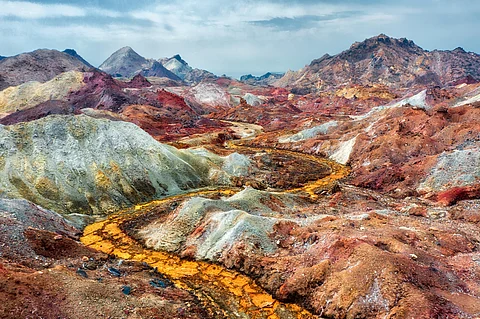
- Destinations
- Experiences
- Stay
- What's new
- Celebrating People
- Responsible Tourism
- CampaignsCampaigns
- SubscribeSubscribe
- Buy Now

Hormuz, an Iranian island in the Persian Gulf, measures just 42 sq km but don’t be fooled by its size—this colourful red ochre landscape attracts visitors from all over the world keen to experience its unique geography and fantastical bird life. The absence of cars on the island means Hormuz is one of the few places in the world where you can literally get away from the congestion of modern city life, making a trip here worthwhile in more ways than one.
Once known as Ormus, the earliest evidence of human presence on the island dates back to over 40,000 years ago, thanks to several stone artefacts that were discovered on its eastern shoreline. However, Hormuz' geological history dates back to 600 million years ago. In the 16th century, the Portuguese conquered the island, building a fort on it and using it as an emergency stopover point for ships travelling to Goa, Gujarat, and Kishm. Famed explorers Ibn Battuta and Marco Polo both visited Hormuz during their lifetime.
It's not a stretch of the imagination to wonder at what drew them to the island. The most eye-catching feature of Hormuz is its reddish ochre landscape, due to which it is often referred to as “Rainbow Island.” Called golak by the residents, the ochre has been exploited for artistic and culinary purposes for centuries and was once the island's top export. The colour has bled into the surrounding water, too; the “tide of blood” changes colour depending on where the red soil is deeper. This phenomenon is particularly striking on the Red Beach.
Situated on Iran's southern coast, which is known for its aridity and salty sea water, Hormuz’ waterways are populated by mangrove forests and attract wild birds like Saunders's terns, great stone-curlews, and sooty gulls. This is reflected in the fact that the island is an Important Bird Area (IBA) as designated by BirdLife International.
The Rainbow Valley has more than 70 shades of red, yellow, purple, blue and orange minerals that render a stellar landscape that will have you reaching for your camera. On all sides, patches of colour form geometric patterns that are best viewed in the late afternoon during golden hour. To preserve this invaluable geological beauty, it is recommended that visitors don't carry soil or rocks outside of the valley.
The southern swathe of Hormuz Island is covered with huge salt crystals that extend more than a kilometre. These shimmering crystals line pale caves and sharp-edged walls that look like the giant columns of a marble palace. Locals believe that the salt possesses the healing power to soak up and release any negative energy.
Walk along the Red Beach for wonderful views of the sea and a peek into the many sea caves that line the shore. Visitors will encounter parts where the sand glitters with metal compounds, a view that is especially mesmerising at sunset or sunrise.
Here, rocks were weathered into fantastical shapes by thousands of years of wind erosion. With a bit of imagination, you can see a dragon, birds, and mythical creatures in Earth's own art gallery.
This museum showcases the works of an internationally-renowned local artist whose work focuses on social and environmental art. The quirky and colourful museum includes artworks like sand paintings and dolls made of recycled materials.
This relic is one of the important vestiges from the time of the Portuguese Empire and dates back to 1507. Made from reddish stones on a rocky promontory at the north end of the island, the irregularly shaped and multi-sided construction has towers that reach up to 12 m. The castle was cut off from the rest of the island by a moat, traces of which still remain. Visitors can see the ruins of an arms depot, a water reservoir, the barracks, a prison, a church, a command centre and the central hall.
Take a flight to Tehran's Imam Khomeini International Airport (IKA) from India via Muscat or Dubai. Travel to Bandar Abbas via bus, plane, or car and take the ferry to Hormuz Island from Haqqani Port.
Autumn and winter are generally considered the most comfortable temperatures for exploring the island.
Indian tourists travelling to Hormuz can procure a visa-on-arrival for a maximum 15-day stay in the country.
